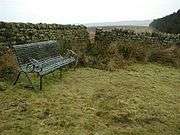Robert Aske (political leader)
Robert Aske (c. 1500 – 12 July 1537) was an English lawyer who became a leader of rebellion in Yorkshire. He pushed the Pilgrimage of Grace uprising against the dissolution of lesser monasteries in 1536; King Henry VIII had him executed for treason on 12 July 1537.
Life
Aske was a younger son of Sir Robert Aske of Aughton near Selby, a scion of an old Yorkshire family. Aske was well connected: his mother, Elizabeth Clifford, was a daughter of John Clifford, 9th Baron de Clifford, and Margaret Bromflete; and Henry Clifford, 2nd Earl of Cumberland, was his first cousin once removed.[1] Queen Jane Seymour was also his third cousin, also through his mother.
Aske became a barrister and was a Fellow at Gray's Inn. A devout man, he objected to Henry's religious reforms, particularly the Dissolution of the Monasteries. When rebellion broke out in York against Henry VIII, Aske was returning to Yorkshire from London. Not initially involved in the rebellion, he took up the cause of the rebels and headed the Pilgrimage of Grace. By 10 October 1536 he had come to be regarded as their "chief captain". Most of Yorkshire, and parts of Northumberland, Durham, Cumberland, and Westmorland were in revolt.
Nine thousand insurgents marched on York, where Aske arranged for the expelled monks and nuns to return to their houses; the King's tenants were driven out and religious observance resumed.[2]
On 13 November 1536, Aske treated with the royal delegates, including the Duke of Norfolk, and received an assurance of an audience and safe passage to the King. Among the insurgents' requests was the punishment of heretical bishops and of the King's evil advisers, the recall of his anti-ecclesiastical legislation, the prosecution of his "visitors", Lee and Layton, and the holding of a parliament in the North.[3] He travelled to London, met Henry VIII, and received promises of redress and safe passage.
As he began his journey back north, fighting broke out again. This renewed fighting allowed Henry to change his mind, and he had Robert Aske seized and brought to the Tower of London. He was convicted of high treason in Westminster and was taken back to York, where he was executed on 12 July 1537,[3] on a special scaffold erected outside Clifford's Tower.
Portrayals
All that is known of Aske’s physical appearance is that he was blind in one eye
Aske was played by Sean Bean in the television serial Henry VIII (2003), in which he is inaccurately portrayed as a violent former lieutenant of Henry's army.
Aske was also portrayed by Gerard McSorley in the third season of Showtime's The Tudors. At the time of filming, McSorley was twenty years older than Aske was when he died. The series also shows Aske with a young family, while, in fact, he was not married.
The circumstances surrounding Aske's life feature prominently in C. J. Sansom's novel Sovereign and H. F. M. Prescott's novel The Man on a Donkey.
See also
References
- Gasquet, Francis Aidan, Henry VIII and the English Monasteries (G. Bell, 1906), p. 231

- Burton, Edwin. "Pilgrimage of Grace." The Catholic Encyclopedia Vol. 12. New York: Robert Appleton Company, 1911. 16 August 2018
- Shahan, Thomas. "Robert Aske." The Catholic Encyclopedia Vol. 1. New York: Robert Appleton Company, 1907. 13 Jul. 2015
- . Dictionary of National Biography. London: Smith, Elder & Co. 1885–1900.
External links
- Robert Aske I and II Web site of Haberdashers Aske's School, under reconstruction.
